South Carolina's 6th congressional district
The 6th congressional district of South Carolina is a congressional district in central and eastern South Carolina. It includes all of Allendale, Bamberg, Clarendon, Colleton, Hampton, Jasper and Williamsburg counties and parts of Beaufort, Berkeley, Calhoun, Charleston, Dorchester, Orangeburg, Richland and Sumter counties. The district borders were shifted south in the 2012 redistricting. It lost its share of the North Carolina border, and now takes in part of the area near the South Carolina-Georgia border.
| South Carolina's 6th congressional district | |||
|---|---|---|---|
.tif.png) South Carolina's 6th congressional district - since January 3, 2013. | |||
| Representative |
| ||
| Population (2000) | 668,670 | ||
| Median income | $35,615[1] | ||
| Ethnicity |
| ||
| Cook PVI | D+19[2] | ||
The district's current configuration dates from a deal struck in the early 1990s between state Republicans and Democrats in the South Carolina General Assembly to create a majority-black district. The rural counties of the historical black belt in South Carolina make up much of the district, but it sweeps south to include most of the majority-black precincts in and around Charleston, and sweeps west to include most of the majority-black precincts in and around Columbia. In all of its configurations, its politics have been dominated by black voters in the Columbia and Charleston areas.
Following the Reconstruction era, the white Democratic-dominated legislature passed Jim Crow laws, as well as a new constitution in 1895 that effectively disfranchised blacks, crippling the Republican Party in the state. For most of the next 60 years, South Carolina was essentially a one-party state dominated by the Democrats, and blacks were nearly excluded from the political system.
Demographic and political changes have included the Great Migration of blacks out of the state during the Jim Crow era in the first half of the 20th century. At the same time, many white Democrats felt chagrin at the national party's greater support of civil rights for blacks from the 1940s onward, and began splitting their tickets in federal elections. After successes of the Civil Rights Movement in gaining passage of federal legislation in the mid-1960s to enforce their constitutional rights and ability to vote, blacks in South Carolina supported national Democratic candidates. White conservatives began moving into the Republican Party in the 1980s.
Since the late 20th century, South Carolina politics have been very racially polarized. Republicans in South Carolina have been mostly white, and most African Americans in the state continue to support the Democrats. In the 21st century, the 6th is considered the only "safe" Democratic district in the state.
Before 1993, this district included the northeastern part of the state, from Darlington to Myrtle Beach. In this configuration, it was a classic "Yellow Dog" Democratic district; from the end of Reconstruction until 1993, it only elected two Republicans, both for a single term. In 2012, the new 7th congressional district was created; it includes much of the territory that was in the 6th for most of the 20th century.
Jim Clyburn, a Democrat and the current Majority Whip, has represented this district since first being elected in 1992.
Election results from presidential races
| Year | Result |
|---|---|
| 2004 | John Kerry 61 - 39% |
| 2008 | Barack Obama 70.1 - 28.9% |
| 2012 | Barack Obama 70.9 - 28.1% |
| 2016 | Hillary Clinton 66.8 - 30.3% |
List of members representing the district
| Name | Party | Years | Cong ress |
Electoral history | District location |
|---|---|---|---|---|---|
| District created in 1793 | |||||
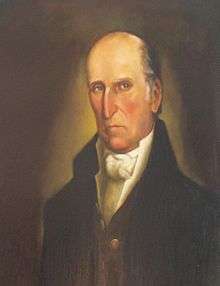 Andrew Pickens |
Anti-Administration | March 4, 1793 – March 3, 1795 |
3rd | Elected in 1793. [data unknown/missing] |
1793–1797 "Pinckney and Washington district" |
| Samuel Earle | Democratic-Republican | March 4, 1795 – March 3, 1797 |
4th | Elected in 1794. Retired. | |
| William Smith | Democratic-Republican | March 4, 1797 – March 3, 1799 |
5th | Elected in 1796. Lost re-election. |
1797–1803 "Washington district" 1796 election results by district |
| Abraham Nott | Federalist | March 4, 1799 – March 3, 1801 |
6th | Elected in 1798. Retired. | |
| Thomas Moore | Democratic-Republican | March 4, 1801 – March 3, 1803 |
7th | Elected in 1800. Redistricted to the 7th district. | |
| Levi Casey | Democratic-Republican | March 4, 1803 – February 3, 1807 |
8th 9th |
Elected in 1803. Re-elected in 1804. Re-elected in 1806. Died. |
1803–1813 "Abbeville district" |
| Vacant | February 3, 1807 – June 2, 1807 | ||||
| Joseph Calhoun | Democratic-Republican | June 2, 1807 – March 3, 1811 |
10th 11th |
Elected to finish Casey's term. Re-elected in 1808. Retired. | |
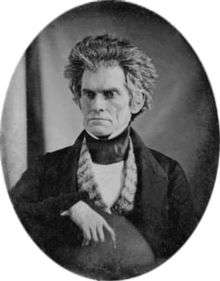 John C. Calhoun |
Democratic-Republican | March 4, 1811 – November 3, 1817 |
12th 13th 14th 15th |
Elected in 1810. Re-elected in 1812. Re-elected in 1814. Re-elected in 1816. Resigned to become U.S. Secretary of War. | |
| 1813–1823 "Abbeville district" | |||||
| Vacant | November 3, 1817 – January 24, 1818 | ||||
| Eldred Simkins | Democratic-Republican | January 24, 1818 – March 3, 1821 |
15th 16th |
Elected to finish Calhoun's term. Re-elected in 1818. Retired. | |
 George McDuffie |
Democratic-Republican | March 4, 1821 – March 3, 1823 |
17th | Elected in 1820. Redistricted to the 5th district. | |
| John Wilson | Jackson Democratic-Republican | March 4, 1823 – March 3, 1825 |
18th 19th |
Redistricted from the 7th district and re-elected in 1823. Re-elected in 1824. Lost re-election. |
1823–1833 "Pendleton district" |
| Jacksonian | March 4, 1825 – March 3, 1827 | ||||
| Warren R. Davis | Jacksonian | March 4, 1827 – March 3, 1831 |
20th 21st 22nd 23rd |
Elected in 1826. Re-elected in 1828. Died. | |
| Nullifier | March 4, 1831 – March 3, 1833 | ||||
| March 4, 1833 – January 29, 1835 |
1833–1843 [data unknown/missing] | ||||
| Vacant | January 29, 1835 – September 10, 1835 | ||||
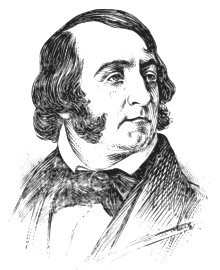 Waddy Thompson Jr. |
Anti-Jackson | September 10, 1835 – March 3, 1837 |
24th 25th 26th |
[data unknown/missing] | |
| Whig | March 4, 1837 – March 3, 1841 | ||||
| William Butler | Whig | March 4, 1841 – March 3, 1843 |
27th | [data unknown/missing] | |
| Isaac E. Holmes | Democratic | March 4, 1843 – March 3, 1851 |
28th 29th 30th 31st |
Redistricted from the 1st district. [data unknown/missing] | |
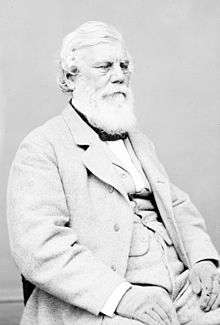 William Aiken Jr. |
Democratic | March 4, 1851 – March 3, 1853 |
32nd | [data unknown/missing] Redistricted to the 2nd district. | |
 William W. Boyce |
Democratic | March 4, 1853 – December 21, 1860 |
33rd 34th 35th 36th |
[data unknown/missing] Retired. | |
| Vacant | December 21, 1860 – March 3, 1867 |
Civil War - Reconstruction | |||
| District eliminated in 1867 | |||||
| District re-established 1883 | |||||
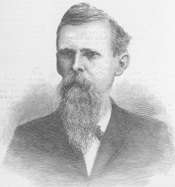 George W. Dargan |
Democratic | March 4, 1883 – March 3, 1891 |
48th 49th 50th 51st |
[data unknown/missing] | |
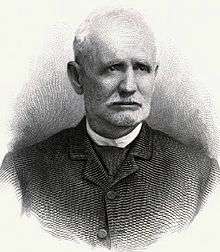 Eli T. Stackhouse |
Democratic | March 4, 1891 – June 14, 1892 |
52nd | [data unknown/missing] Died. | |
| Vacant | June 14, 1892 – December 5, 1892 | ||||
 John L. McLaurin |
Democratic | December 5, 1892 – May 31, 1897 |
52nd 53rd 54th 55th |
[data unknown/missing] Resigned when elected U.S. Senator. | |
| Vacant | May 31, 1897 – December 6, 1897 | ||||
| James Norton | Democratic | December 6, 1897 – March 3, 1901 |
55th 56th |
Elected to finish McLaurin's term. [data unknown/missing] | |
| Robert B. Scarborough | Democratic | March 4, 1901 – March 3, 1905 |
57th 58th |
[data unknown/missing] | |
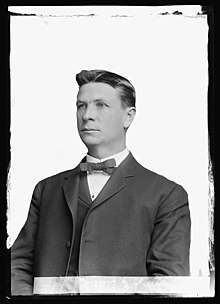 J. Edwin Ellerbe |
Democratic | March 4, 1905 – March 3, 1913 |
59th 60th 61st 62nd |
[data unknown/missing] | |
| J. Willard Ragsdale | Democratic | March 4, 1913 – July 23, 1919 |
63rd 64th 65th 66th |
[data unknown/missing] Died. | |
| Vacant | July 23, 1919 – October 7, 1919 | ||||
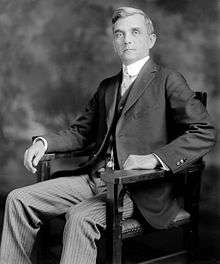 Philip H. Stoll |
Democratic | October 7, 1919 – March 3, 1923 |
66th 67th |
[data unknown/missing] | |
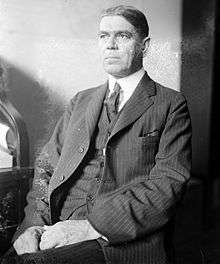 Allard H. Gasque |
Democratic | March 4, 1923 – June 17, 1938 |
68th 69th 70th 71st 72nd 73rd 74th 75th |
[data unknown/missing] Died. | |
| Vacant | June 17, 1938 – September 13, 1938 | ||||
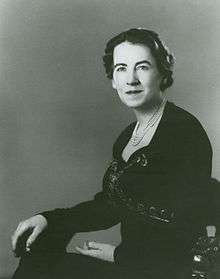 Elizabeth H. Gasque |
Democratic | September 13, 1938 – January 3, 1939 |
75th | [data unknown/missing] | |
 John L. McMillan |
Democratic | January 3, 1939 – January 3, 1973 |
76th 77th 78th 79th 80th 81st 82nd 83rd 84th 85th 86th 87th 88th 89th 90th 91st 92nd |
[data unknown/missing] Lost renomination. | |
 Edward Lunn Young |
Republican | January 3, 1973 – January 3, 1975 |
93rd | Elected in 1972. Lost re-election. |
1973–1983: [data unknown/missing] |
 John Jenrette |
Democratic | January 3, 1975 – December 10, 1980 |
94th 95th 96th |
[data unknown/missing] Lost re-election and resigned early as a result of the ABSCAM scandal. | |
 John L. Napier |
Republican | January 3, 1981 – January 3, 1983 |
97th | [data unknown/missing] Lost re-election. | |
 Robin Tallon |
Democratic | January 3, 1983 – January 3, 1993 |
98th 99th 100th 101st 102nd |
[data unknown/missing] Retired when district was Redistricted as a minority-majority district. |
1983–1993: [data unknown/missing] |
 Jim Clyburn |
Democratic | January 3, 1993 – present |
103rd 104th 105th 106th 107th 108th 109th 110th 111th 112th 113th 114th 115th 116th |
Elected in 1992. Re-elected in 1994. Re-elected in 1996. Re-elected in 1998. Re-elected in 2000. Re-elected in 2002. Re-elected in 2004. Re-elected in 2006. Re-elected in 2008. Re-elected in 2010. Re-elected in 2012. Re-elected in 2014. Re-elected in 2016. Re-elected in 2018. |
1993–2003: [data unknown/missing] |
2003–2013: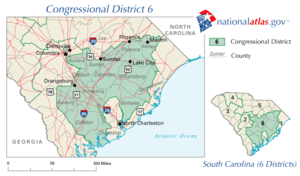 | |||||
2013–present:.tif.png) | |||||
References
- https://www.census.gov/mycd/?st=45&cd=06
- "Partisan Voting Index – Districts of the 115th Congress" (PDF). The Cook Political Report. April 7, 2017. Retrieved April 7, 2017.
- Martis, Kenneth C. (1989). The Historical Atlas of Political Parties in the United States Congress. New York: Macmillan Publishing Company.
- Martis, Kenneth C. (1982). The Historical Atlas of United States Congressional Districts. New York: Macmillan Publishing Company.
- Congressional Biographical Directory of the United States 1774–present